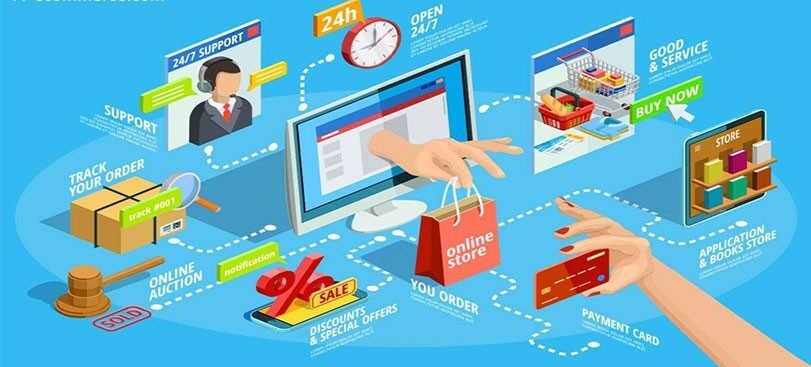A simple formula has been the key to success in commerce for centuries. Find a profitable place for your cart. To attract more foot traffic, shout louder than your competition. To make more profit, operate at a lower price.
[powerkit_toc title=”Table of Contents” depth=”2″ min_count=”4″ min_characters=”1000″ btn_hide=”true” default_state=”expanded”]
It’s not so simple in the 21st century. Digital-first retail brands can now make it easier to get a place even in highly saturated markets. If you are planning to open an online store in 2021, there is plenty of room for growth.
Statistics of Selling Online
- 46% of U.S. customers tried new brands or placed orders at new retailers in the last year. Online shopping is making it easier for consumers to switch brands because of the ease and blurred geographic lines.
- Accenture’s May 2020 study found that the volume of purchases made by inexperienced or infrequent online shoppers is likely to rise 160% over the next year. Last year, many people discovered how much they appreciate online shopping and were becoming more used to it.

- By September 2022, 50% of all online purchases will be made via smartphones. The U.S. In 2020, mobile phones were used by more than $190 billion Americans.
- The web traffic to smaller e-commerce sites increased by 96.5% between October 2019 and October 2020. Over a third of those surveyed reported an increase in web traffic between 100 and 2000%. This growth is expected to continue in the future, according to most.
8 Steps for Creating an Online Store
You can create a website with a simple piece of software that allows you to sell products. How can you grow your business beyond the minimum viable product? These are the steps.

- Select a niche to develop a business plan
- Select your domain name
- Pick your e-commerce website builder
- Create the look for your online store
- Add products to your online store
- Set up shipping
- Market your online store
- Launch your online store
Select a Niche & Create a Business Plan

Ecommerce is extremely diverse. Amazon online store, one of the world’s largest e-commerce companies, was once a niche retailer. To identify your niche, do background research on e-commerce niches.
Locate Industry Gaps
It may appear that all the good niches in e-commerce are already taken. It’s false. Targeted research can reveal unmet consumer needs even within the most popular product categories. Toys, for example, are plentiful. Parents are worried that their kids might be exposed to dangerous chemical compounds.
Use it to Find Opportunities in Your Market
- Social media — Analyze concerns, complaints, and requests for recommendations as voiced by your target audience.
- Google Trends — Compare and contrast search volumes for different product types over time.
- Shop bestsellers on Amazon or eBay. Read reviews to see what shoppers think and what they have to say.
Analyze Your Customer Personas
The intersection of needs, preferences, and interests is where the best e-commerce product ideas come from online store.
Create Ideal Buyer Personas by Populated with:
- Demographic Data — Age, Location, Occupation, Income
- Data psychographic — values, interests, beliefs, struggles, aspirations
Select the Best Business Model.
You should also consider where and how often your target audience buys products as part of your customer research.
- B2B eCommerce — Can you see yourself selling to more wholesalers, retailers, and business buyers?
- B2C e-commerce — Would you prefer to market your products directly to consumers?
- Selling on online marketplaces — Many popular marketplaces like Amazon, eBay, and Etsy offer built-in access for a wide range of customers.
- Drop shipping — This model transfers order fulfillment tasks to third parties, so you don’t have any inventory.
- DTC — Direct-to-consumer (DTC) eliminates the need for intermediaries (multi-brand retailers or wholesalers).
You can find our explanation of the different types of e-commerce models in this detailed guide.
Select Your Domain Name

A domain name is just like your business name. It’s your unique identifier to consumers. The right domain name will not only direct them to your online shop but can also increase brand recall and awareness. How to create a domain name for your e-commerce site.
Be Unique
Small business owners used to love “exact match” domain names like buytoysonline.com. Keyword-rich names were easier to rank for in search results. However, they aren’t the best for all businesses.
Instead, opt for a unique name. This is how you can get one:
- Mesh two words: “Big + Commerce.”
- Use a real descriptive verb: e.g. Burrow — den, refuge.
- Experiment with foreign terms: e.g. Natori
Avoid Using Unfamiliar Words & Creative Spellings
However, you should not get too creative with compounding words. It is possible to end up with something offensively or inappropriately funny.
- Amigone Funeral Homes => AmIGonefuneralhome.com
You should choose a domain name that has no
- Unintentional combination words
- Numbers and hyphens (except when part of the brand)
- Misspelled words (as people mistype them as the correct ones)
- Hard-to-pronounce combos
Pick Your Ecommerce Website Builder
There are many types of e-commerce platforms, each with its own set of extensions and native features. You can identify the right platform for your business by creating a prioritized list. This list will include the most important function as well as the “nice-to-haves.” Next, you will need to analyze the open-source and SaaS options.
Consider these Things When Selecting an E-Commerce Platform.
It might be tempting to choose the most affordable website builder. However, you might have to migrate your e-commerce website later. This can be a problem. Even if your first iteration isn’t yet finished, think about the long-term.
Ask when analyzing various options:
- Is this platform you are able to grow with my business?
- What happens if my business exceeds a certain level of traffic or sales?
Other than scalability, it is also important to consider:
Native Features
Is the online store platform able to provide core commerce features? What additional functionality will you need to add or create yourself?
Create a list of requirements and rank each feature in order of necessity. Then, assess multiple store builders to determine their scores.
Security
Data breaches in eCommerce online store are both a reputational and financial risk. Modern consumers are likely to reconsider buying from an online shop that offers limited options.
- Recently, was the victim of a system hack or data leak
- No SSL security at checkout
- Does not provide any information about payment processing or data storage
Mobile Optimization
Did you know that Google has been using mobile indexing across the web since 2020? You need to ensure that your e-commerce platform offers a great mobile shopping experience.
Google crawlers use data about how your website looks on mobile devices to determine your website’s rank in mobile and desktop SERPs.
Your SEO page rankings may be affected if your online store doesn’t support mobile devices. This could lead to lower website traffic. Mobile sales could also be lost if your online store is not mobile-friendly.
Big Commerce
Big Commerce is an open SaaS eCommerce platform that offers a variety of native commerce features, integrated payments processing, and secure hosting. It can be easily extended with custom integrations if your business is well-positioned for growth. You can also use Big Commerce as a headless commerce platform and connect to any front-end you choose.
Features:
- Visual drag and drop page builder and editing HTML and CSS
- Integration with 55+ Payment Gateways
- Supports up to 600 SKUs per Product
- Allows payment in 140+ local currencies in more than 95 countries
Shopify
Shopify online store, a SaaS e-commerce platform, offers a wide range of features that will help you get your online store started. It caters to small businesses as well as larger mid-market shops. It offers both native and third-party integrations that can be used with other business apps.
Features:
- Visual page creator and direct editing HTML/CSS
- Integration with over 100 payment gateways. Additional transaction fees may apply to merchants who use a secondary gateway to Shopify.
- Secure shopping cart functionality
Online Store
Big-Commerce is an e-commerce website builder that offers a wide selection of themes and can be arranged by verticals. Select the template that best suits your needs, then modify it to match your business’ branding:

- Modify fonts and sizes
- Create high-quality visuals and brand assets
- Configure your color scheme
- Embed social media accounts and brand content
- Try out different layouts and product listing styles.
Add Products To Your Online Store
Set up product pages for your store that are easy to navigate and have great product descriptions. Upload product images to sell.



